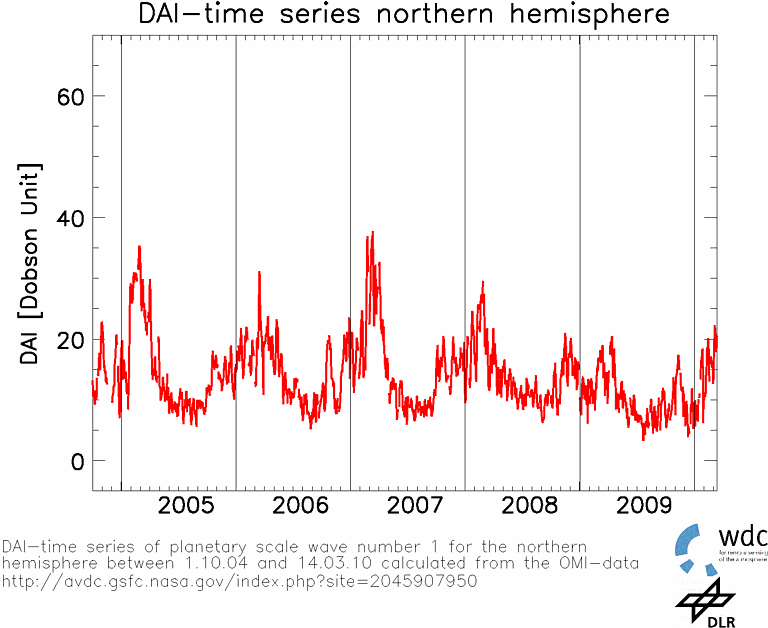Winter in the stratosphere ends



There are also signs of the approaching end of winter in the stratosphere: the large-scale dynamic activity has been increasing since mid-December 2009 and appears to be collapsing in the next few days - a sign of the reversal from winter to summer circulation.
Until the first measurements of the ozone hole about 30 years ago, the stratospheric altitude range between about 15 and 50 kilometres was of little interest. Due to the fact that around 50% of the atmospheric air masses are below 5 kilometres, the focus was primarily on this area, which has a direct influence on humans through weather development. However, the ozone maximum in the stratosphere, the ozone layer, which protects us from large amounts of harmful UV radiation, also has a direct influence on us.
The development of the ozone layer in general and the ozone hole in particular are determined by both chemical and dynamic processes in the atmosphere, the planetary waves. These are wave phenomena that span the entire globe and are responsible for the large-scale transport of energy and momentum in the atmosphere. Ozone reproduces the movements of planetary waves at certain altitudes, making them visible. Analysing the ozone concentration in the atmosphere always provides a picture of the dynamic situation. Such analyses are routinely produced at DLR in the form of the Dynamic Activity Index (DAI), updated daily and made available in the ICSU/WMO World Data Centre for Remote Sensing of the Atmosphere, WDC-RSAT (http://wdc.dlr.de).
The DAI reflects the activity of planetary waves separately for the respective hemisphere in the stratosphere. It typically increases over the course of a winter until it finally collapses around March (see Figure 1). This is associated with the change in atmospheric circulation from winter to summer conditions. The steady rise is normally interrupted abruptly once per winter, usually in conjunction with stratospheric warming, one of the most dramatic phenomena in the atmosphere. The very cold winter stratosphere warms by several 10°K within a few days, and under certain circumstances there is even a large-scale circulation reversal, i.e. a short-term switch from winter to summer. This phenomenon counteracts the formation of the ozone hole because air masses from low geographic latitudes are mixed with polar air masses, as Figure 2 shows. The shift and break-up of the low-ozone region on 26 January 2010 can be clearly seen here, based on data from the GOME-2 instrument on the MetOp satellite, which is routinely assimilated into a 4D-Var atmospheric model at DLR in cooperation with EUMETSAT. Stratospheric warming is one of the main reasons why the classic ozone hole has so far only been observed in the southern hemisphere. Evidence of stratospheric warming can also be found in the DAI time series of the current winter at the end of January this year (see Figure 3). Since then, planetary wave activity has been increasing again. It is characterised by pulses of varying strength, which can be attributed to planetary waves themselves or their interactions. It is to be expected that the current increase will come to an end in the next few days due to the final change in circulation.
